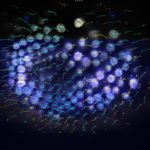Link to Pubmed [PMID] – 26056271
Link to DOI – 10.1073/pnas.1509091112
Proc Natl Acad Sci U S A 2015 Jun; 112(25): E3282-90
Few studies within the pathogenic field have used advanced imaging and analytical tools to quantitatively measure pathogenicity in vivo. In this work, we present a novel approach for the investigation of host-pathogen processes based on medium-throughput 3D fluorescence imaging. The guinea pig model for Shigella flexneri invasion of the colonic mucosa was used to monitor the infectious process over time with GFP-expressing S. flexneri. A precise quantitative imaging protocol was devised to follow individual S. flexneri in a large tissue volume. An extensive dataset of confocal images was obtained and processed to extract specific quantitative information regarding the progression of S. flexneri infection in an unbiased and exhaustive manner. Specific parameters included the analysis of S. flexneri positions relative to the epithelial surface, S. flexneri density within the tissue, and volume of tissue destruction. In particular, at early time points, there was a clear association of S. flexneri with crypts, key morphological features of the colonic mucosa. Numerical simulations based on random bacterial entry confirmed the bias of experimentally measured S. flexneri for early crypt targeting. The application of a correlative light and electron microscopy technique adapted for thick tissue samples further confirmed the location of S. flexneri within colonocytes at the mouth of crypts. This quantitative imaging approach is a novel means to examine host-pathogen systems in a tailored and robust manner, inclusive of the infectious agent.


